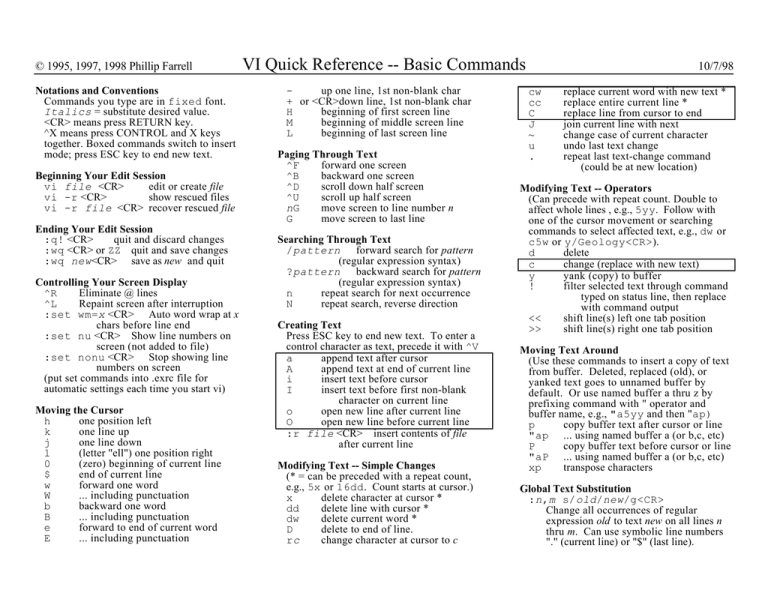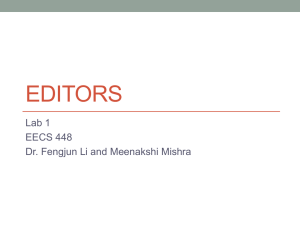Document 11361355
advertisement

© 1995, 1997, 1998 Phillip Farrell Notations and Conventions Commands you type are in fixed font. Italics = substitute desired value. <CR> means press RETURN key. ^X means press CONTROL and X keys together. Boxed commands switch to insert mode; press ESC key to end new text. Beginning Your Edit Session vi file <CR> edit or create file vi -r <CR> show rescued files vi -r file <CR> recover rescued file Ending Your Edit Session :q! <CR> quit and discard changes :wq <CR> or ZZ quit and save changes :wq new<CR> save as new and quit Controlling Your Screen Display ^R Eliminate @ lines ^L Repaint screen after interruption :set wm=x <CR> Auto word wrap at x chars before line end :set nu <CR> Show line numbers on screen (not added to file) :set nonu <CR> Stop showing line numbers on screen (put set commands into .exrc file for automatic settings each time you start vi) Moving the Cursor h one position left k one line up j one line down l (letter "ell") one position right 0 (zero) beginning of current line $ end of current line w forward one word W ... including punctuation b backward one word B ... including punctuation e forward to end of current word E ... including punctuation VI Quick Reference -- Basic Commands up one line, 1st non-blank char + or <CR>down line, 1st non-blank char H beginning of first screen line M beginning of middle screen line L beginning of last screen line Paging Through Text ^F forward one screen ^B backward one screen ^D scroll down half screen ^U scroll up half screen nG move screen to line number n G move screen to last line Searching Through Text /pattern forward search for pattern (regular expression syntax) ?pattern backward search for pattern (regular expression syntax) n repeat search for next occurrence N repeat search, reverse direction Creating Text Press ESC key to end new text. To enter a control character as text, precede it with ^V a append text after cursor A append text at end of current line i insert text before cursor I insert text before first non-blank character on current line o open new line after current line O open new line before current line :r file <CR> insert contents of file after current line Modifying Text -- Simple Changes (* = can be preceded with a repeat count, e.g., 5x or 16dd. Count starts at cursor.) x delete character at cursor * dd delete line with cursor * dw delete current word * D delete to end of line. rc change character at cursor to c 10/7/98 cw cc C J ~ u . replace current word with new text * replace entire current line * replace line from cursor to end join current line with next change case of current character undo last text change repeat last text-change command (could be at new location) Modifying Text -- Operators (Can precede with repeat count. Double to affect whole lines , e.g., 5yy. Follow with one of the cursor movement or searching commands to select affected text, e.g., dw or c5w or y/Geology<CR>). d delete c change (replace with new text) y yank (copy) to buffer ! filter selected text through command typed on status line, then replace with command output << shift line(s) left one tab position >> shift line(s) right one tab position Moving Text Around (Use these commands to insert a copy of text from buffer. Deleted, replaced (old), or yanked text goes to unnamed buffer by default. Or use named buffer a thru z by prefixing command with " operator and buffer name, e.g., "a5yy and then "ap) p copy buffer text after cursor or line "ap ... using named buffer a (or b,c, etc) P copy buffer text before cursor or line "aP ... using named buffer a (or b,c, etc) xp transpose characters Global Text Substitution :n,m s/old/new/g<CR> Change all occurrences of regular expression old to text new on all lines n thru m. Can use symbolic line numbers "." (current line) or "$" (last line).











